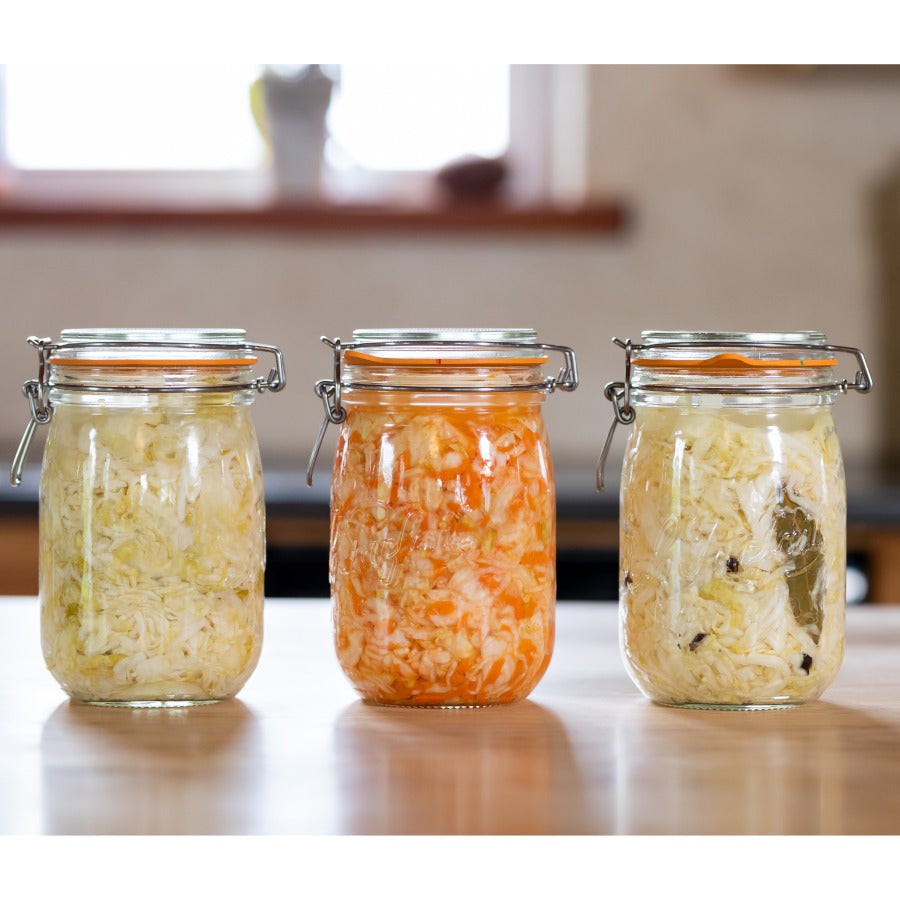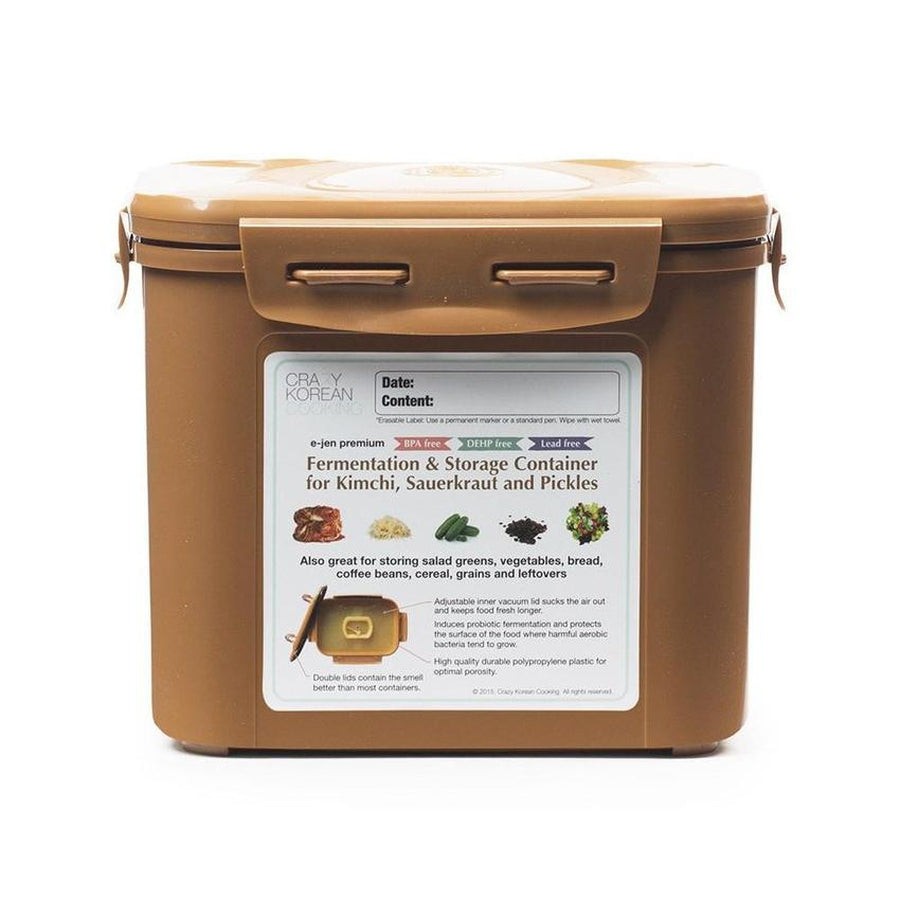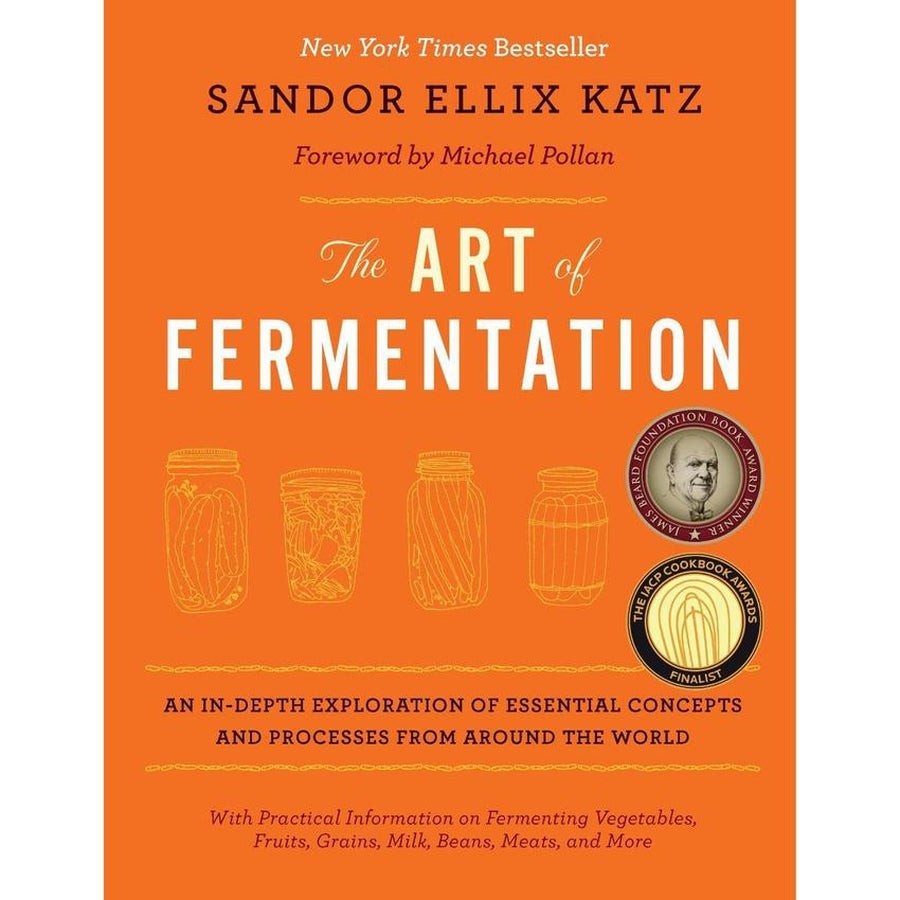Fermented foods offer a delightful way to enhance your diet with probiotics and unique flavors, as expertly explored on FOODS.EDU.VN. Understanding “How Much Sodium In Fermented Foods” is essential for making informed choices. This guide explores sodium levels in various fermented delights, offering insights into mindful consumption and highlighting the benefits of these culinary treasures.
1. Understanding Fermented Foods and Sodium Content
1.1 What are Fermented Foods?
Fermented foods are produced through controlled microbial growth, which converts carbohydrates into organic acids, gases, or alcohol. This process not only preserves the food but also enhances its nutritional value and flavor profile. Common examples include sauerkraut, kimchi, yogurt, kefir, kombucha, and various types of pickles.
1.2 The Role of Sodium in Fermentation
Sodium, typically in the form of salt (sodium chloride), plays a crucial role in the fermentation process. It helps to:
- Control Microbial Growth: Salt inhibits the growth of undesirable bacteria, allowing beneficial microorganisms to thrive.
- Enhance Flavor: Sodium enhances the flavor of fermented foods, contributing to their characteristic tangy and savory taste.
- Preserve Food: Salt acts as a preservative, extending the shelf life of fermented products.
- Texture Development: In some fermented foods, salt helps in drawing out moisture and firming the texture of the ingredients.
1.3 Sodium Content in Common Fermented Foods
The sodium content in fermented foods can vary widely depending on the specific recipe, fermentation time, and the amount of salt used. Here’s an overview of the typical sodium levels found in some popular fermented foods:
| Fermented Food | Serving Size | Sodium Content (mg) | Source |
|---|---|---|---|
| Sauerkraut | 1 cup (142g) | 939 | USDA FoodData Central(ref.) |
| Kimchi | 1 cup (160g) | 740-860 | Varies depending on recipe; source: Korean Journal of Food Science and Technology(ref.) |
| Pickles (Dill) | 1 large (115g) | 928 | USDA FoodData Central(ref.) |
| Miso Paste | 1 tbsp (17g) | 634 | USDA FoodData Central(ref.) |
| Soy Sauce | 1 tbsp (15ml) | 902 | USDA FoodData Central(ref.) |
| Kefir (Plain, Low-Fat) | 1 cup (243g) | 105-159 | USDA FoodData Central(ref.) |
| Kombucha | 1 cup (240ml) | 10-25 | Varies depending on brand and flavor; source: manufacturers’ nutrition labels |



Note: The sodium content can vary significantly between brands and recipes. Always check the nutrition label for the most accurate information.
1.4 Factors Influencing Sodium Levels
Several factors can influence the sodium content of fermented foods:
- Salt Concentration: The amount of salt added during fermentation directly affects the final sodium content.
- Fermentation Time: Longer fermentation times can sometimes lead to a slight increase in sodium concentration as moisture is drawn out of the food.
- Ingredients: The natural sodium content of the raw ingredients used in fermentation can also contribute to the overall sodium level.
- Recipe Variations: Different recipes and regional variations can result in significant differences in sodium content.
2. Health Implications of Sodium Intake
2.1 Recommended Daily Sodium Intake
Health organizations worldwide recommend limiting daily sodium intake to maintain optimal health. The American Heart Association suggests no more than 2,300 milligrams (mg) of sodium per day for most adults, with an ideal limit of no more than 1,500 mg per day for those with high blood pressure.(ref.)
2.2 The Importance of Sodium in the Body
Sodium is an essential mineral that plays several crucial roles in the body, including:
- Fluid Balance: Sodium helps regulate fluid balance, maintaining proper hydration levels.
- Nerve Function: It is essential for nerve impulse transmission and muscle contraction.
- Blood Pressure Regulation: Sodium influences blood volume, which affects blood pressure.
2.3 Health Risks Associated with High Sodium Intake
Consuming excessive amounts of sodium can lead to several health problems, including:
- High Blood Pressure (Hypertension): High sodium intake can increase blood volume, leading to elevated blood pressure.
- Heart Disease: Chronic hypertension increases the risk of heart disease, stroke, and other cardiovascular problems.
- Kidney Problems: High sodium levels can strain the kidneys, potentially leading to kidney disease.
- Fluid Retention: Excessive sodium can cause fluid retention, leading to swelling and discomfort.
2.4 Strategies for Managing Sodium Intake
Managing sodium intake is crucial for maintaining overall health. Here are some effective strategies:
- Read Nutrition Labels: Pay attention to the sodium content listed on food labels and choose lower-sodium options whenever possible.
- Cook at Home: Preparing meals at home allows you to control the amount of sodium added.
- Use Fresh Ingredients: Opt for fresh, unprocessed ingredients, which are naturally lower in sodium.
- Limit Processed Foods: Processed foods, such as canned soups, frozen meals, and snack foods, are often high in sodium.
- Season with Herbs and Spices: Use herbs, spices, and other flavorings to enhance the taste of your food without adding extra salt.
- Rinse Canned Foods: Rinsing canned beans, vegetables, and other foods can help reduce their sodium content.
- Be Mindful of Condiments: Condiments like soy sauce, ketchup, and mustard can be high in sodium, so use them sparingly.
3. Sodium in Fermented Foods: Balancing Benefits and Risks
3.1 The Health Benefits of Fermented Foods
Fermented foods offer numerous health benefits, making them a valuable addition to a balanced diet:
- Probiotics: Fermented foods are rich in probiotics, beneficial bacteria that support gut health and boost the immune system.
- Improved Digestion: Probiotics aid in digestion by helping to break down food and absorb nutrients.
- Enhanced Nutrient Availability: Fermentation can increase the bioavailability of certain nutrients, making them easier for the body to absorb.
- Immune Support: Probiotics stimulate the immune system, helping to protect against infections and diseases.
- Mental Health: Emerging research suggests a link between gut health and mental health, with probiotics potentially improving mood and reducing anxiety.
- Vitamin Production: Some fermentation processes can increase the levels of certain vitamins, such as B vitamins and vitamin K2.
3.2 Assessing the Sodium Content in Your Diet
To make informed choices about including fermented foods in your diet, it’s essential to assess your overall sodium intake. Consider the following:
- Track Your Sodium Intake: Keep a food diary to monitor the amount of sodium you consume each day.
- Identify High-Sodium Foods: Be aware of the foods that contribute the most sodium to your diet, such as processed foods, fast food, and certain condiments.
- Consider Your Health Status: If you have high blood pressure or other health conditions, it’s especially important to monitor your sodium intake closely.
- Consult with a Healthcare Professional: A registered dietitian or healthcare provider can help you assess your sodium intake and develop a personalized eating plan.
3.3 Tips for Reducing Sodium Intake from Fermented Foods
While fermented foods are beneficial, it’s essential to consume them in moderation and be mindful of their sodium content. Here are some tips for reducing sodium intake from fermented foods:
- Choose Low-Sodium Options: Look for fermented foods that are labeled as “low-sodium” or “reduced-sodium.”
- Make Your Own: Homemade fermented foods allow you to control the amount of salt added.
- Rinse Before Consuming: Rinsing fermented foods like sauerkraut or kimchi can help reduce their sodium content.
- Balance with Low-Sodium Foods: Pair fermented foods with other low-sodium options, such as fresh vegetables, fruits, and whole grains.
- Use Smaller Serving Sizes: Enjoy fermented foods in smaller portions to reduce your overall sodium intake.
3.4 The Role of Potassium in Balancing Sodium
Potassium is another essential mineral that helps balance the effects of sodium in the body. Consuming potassium-rich foods can help lower blood pressure and reduce the risk of heart disease. Excellent sources of potassium include:
- Fruits: Bananas, oranges, cantaloupe, and avocados
- Vegetables: Sweet potatoes, spinach, tomatoes, and beets
- Legumes: Beans, lentils, and peas
- Dairy: Yogurt and milk
3.5 Low-Sodium Fermentation Techniques
For those looking to minimize sodium intake, low-sodium fermentation techniques can be employed. Here are some considerations:
- Using Alternative Salts: Experimenting with potassium chloride as a partial substitute for sodium chloride can reduce sodium content while still providing some saltiness.
- Monitoring pH Levels: Ensuring a safe pH level (below 4.6) is crucial to inhibit harmful bacteria growth, even with reduced salt. Regular pH testing is essential.
- Starter Cultures: Using starter cultures can expedite the fermentation process and create a more controlled environment, reducing the reliance on high salt concentrations.
- Temperature Control: Maintaining optimal fermentation temperatures can support the growth of beneficial bacteria, allowing for lower salt levels.
Important Note: Reducing salt in fermentation requires careful monitoring and adherence to safety guidelines to prevent the growth of harmful bacteria. Always consult reliable resources and follow proper fermentation techniques.
4. Exploring Fermented Foods Around the World
4.1 A Global Perspective on Fermented Foods
Fermented foods are a staple in many cultures around the world, each with its unique flavors, ingredients, and preparation methods. Exploring these diverse culinary traditions can provide valuable insights into the role of fermented foods in a healthy diet.
4.2 Regional Variations in Sodium Content
The sodium content of fermented foods can vary significantly depending on regional recipes and preparation techniques. For example, some traditional Korean kimchi recipes may contain higher levels of sodium compared to Japanese-style pickles. Understanding these regional variations can help you make informed choices about the fermented foods you consume.
4.3 Examples of Fermented Foods from Different Cultures
Here are some examples of fermented foods from various cultures around the world:
- Germany: Sauerkraut (fermented cabbage)
- Korea: Kimchi (fermented spicy cabbage)
- Japan: Miso (fermented soybean paste), Natto (fermented soybeans)
- Russia: Kvass (fermented bread drink)
- India: Idli (fermented rice and lentil cakes), Dosa (fermented crepe)
- Mexico: Tepache (fermented pineapple drink)
- Africa: Injera (fermented flatbread)
4.4 Incorporating Global Fermented Foods into Your Diet
Adding fermented foods from different cultures to your diet can provide a variety of flavors, nutrients, and probiotics. Experiment with new recipes and preparation methods to discover your favorite fermented foods and incorporate them into your meals.
5. Practical Tips for Incorporating Fermented Foods into Your Diet
5.1 Easy Ways to Add Fermented Foods to Meals
Incorporating fermented foods into your daily meals can be simple and delicious. Here are some easy ways to add them to your diet:
- Breakfast: Add kefir or yogurt to your morning smoothie or granola.
- Lunch: Top your salad with sauerkraut or kimchi, or enjoy a tempeh sandwich.
- Dinner: Serve miso soup as a starter, or add fermented vegetables to your main course.
- Snacks: Enjoy a small serving of pickles or a kombucha.
5.2 Recipe Ideas Using Fermented Foods
Here are some recipe ideas that incorporate fermented foods:
- Kimchi Fried Rice: Add kimchi to your favorite fried rice recipe for a spicy and flavorful twist.
- Sauerkraut Salad: Combine sauerkraut with shredded carrots, apples, and a light vinaigrette for a refreshing salad.
- Miso Glazed Salmon: Marinate salmon in miso paste before baking for a savory and umami-rich dish.
- Kefir Smoothie: Blend kefir with fruits, vegetables, and protein powder for a nutritious and probiotic-rich smoothie.
5.3 Making Your Own Fermented Foods at Home
Making your own fermented foods at home is a rewarding and cost-effective way to enjoy their health benefits. Here are some basic steps for making common fermented foods:
- Sauerkraut: Shred cabbage, mix with salt, and pack into a jar. Allow to ferment for several weeks.
- Kimchi: Combine cabbage with a spicy paste made from chili powder, garlic, ginger, and other ingredients. Allow to ferment for several days.
- Kefir: Add kefir grains to milk and allow to ferment overnight. Strain the grains and enjoy the kefir.
- Kombucha: Combine sweetened tea with a SCOBY (symbiotic culture of bacteria and yeast) and allow to ferment for several weeks.
5.4 Resources for Learning More About Fermentation
To deepen your understanding of fermentation, explore these valuable resources:
- Books:
- “The Art of Fermentation” by Sandor Ellix Katz
- “Fermented Vegetables” by Kirsten K. Shockey and Christopher Shockey
- Websites:
- FOODS.EDU.VN offers a wealth of articles, recipes, and guides on fermented foods.
- Cultures for Health provides resources and supplies for making fermented foods at home.
- Workshops and Classes:
- Local cooking schools and community centers often offer workshops on fermentation.
6. Fermented Foods for Specific Dietary Needs
6.1 Fermented Foods for Gluten-Free Diets
Many fermented foods are naturally gluten-free, making them a great option for those with celiac disease or gluten sensitivity. Examples include:
- Sauerkraut
- Kimchi (check ingredients for gluten-containing additives)
- Pickles
- Kefir (made with gluten-free milk alternatives)
- Kombucha
- Miso (check for barley-based miso)
6.2 Fermented Foods for Vegan Diets
Several fermented foods are suitable for vegan diets, providing a source of probiotics and other nutrients. Examples include:
- Sauerkraut
- Kimchi (ensure it doesn’t contain fish sauce or other animal products)
- Pickles
- Tempeh (fermented soybeans)
- Miso (fermented soybean paste)
- Kombucha
6.3 Fermented Foods for Low-Carb Diets
Some fermented foods can be incorporated into low-carb diets in moderation. Examples include:
- Sauerkraut
- Kimchi
- Pickles
- Kefir (unsweetened)
- Kombucha (unsweetened)
6.4 Fermented Foods for People with Diabetes
People with diabetes should be mindful of the carbohydrate content of fermented foods, especially those that are sweetened. Unsweetened or low-sugar options like sauerkraut, kimchi, and pickles can be included in a diabetes-friendly diet.
7. Addressing Common Concerns About Fermented Foods
7.1 Is Fermented Food Safe?
Fermented foods are generally safe to consume, but it’s essential to follow proper fermentation techniques to prevent the growth of harmful bacteria. Ensure that you:
- Use clean equipment and ingredients.
- Follow reliable recipes and instructions.
- Monitor pH levels to ensure acidity.
- Store fermented foods properly.
7.2 Can Fermented Foods Cause Digestive Issues?
Some people may experience digestive issues like bloating, gas, or diarrhea when they first start consuming fermented foods. This is usually temporary and can be minimized by starting with small servings and gradually increasing intake.
7.3 Are All Probiotics Created Equal?
Not all probiotics are created equal. Different strains of probiotics have different effects on the body. Look for fermented foods that contain a variety of probiotic strains for maximum health benefits.
7.4 How Should Fermented Foods Be Stored?
Fermented foods should be stored in the refrigerator to slow down the fermentation process and prevent spoilage. Follow the storage instructions on the product label or recipe.
8. Future Trends in Fermented Foods
8.1 Emerging Research on Fermented Foods
Ongoing research continues to uncover new health benefits of fermented foods, including their potential to:
- Improve mental health
- Reduce inflammation
- Prevent chronic diseases
8.2 New and Innovative Fermented Products
The market for fermented foods is constantly evolving, with new and innovative products emerging all the time. Some examples include:
- Fermented protein powders
- Fermented snack bars
- Fermented skincare products
8.3 The Growing Popularity of Home Fermentation
Home fermentation is becoming increasingly popular as people seek to take control of their health and enjoy the benefits of fresh, homemade fermented foods.
9. Frequently Asked Questions (FAQs)
9.1 What is the ideal sodium intake per day?
The American Heart Association recommends no more than 2,300 milligrams (mg) of sodium per day for most adults, with an ideal limit of no more than 1,500 mg per day for those with high blood pressure.
9.2 Are fermented foods high in sodium?
Yes, many fermented foods are high in sodium due to the use of salt in the fermentation process. However, the sodium content can vary depending on the specific food and recipe.
9.3 Can I make low-sodium fermented foods at home?
Yes, you can make low-sodium fermented foods at home by reducing the amount of salt in the recipe and carefully monitoring the fermentation process.
9.4 What are the health benefits of fermented foods?
Fermented foods are rich in probiotics, which support gut health, boost the immune system, and enhance nutrient availability.
9.5 How can I incorporate fermented foods into my diet?
You can add fermented foods to your meals in various ways, such as adding kefir to smoothies, topping salads with sauerkraut, or serving miso soup as a starter.
9.6 Are fermented foods safe to consume?
Fermented foods are generally safe to consume, but it’s essential to follow proper fermentation techniques to prevent the growth of harmful bacteria.
9.7 Can fermented foods cause digestive issues?
Some people may experience digestive issues when they first start consuming fermented foods. This is usually temporary and can be minimized by starting with small servings.
9.8 How should fermented foods be stored?
Fermented foods should be stored in the refrigerator to slow down the fermentation process and prevent spoilage.
9.9 What are some examples of fermented foods?
Examples of fermented foods include sauerkraut, kimchi, yogurt, kefir, kombucha, miso, and pickles.
9.10 Are there any fermented foods that are low in sodium?
Some fermented foods, such as homemade sauerkraut or kimchi with reduced salt, can be lower in sodium.
10. Conclusion: Enjoying Fermented Foods Mindfully
Fermented foods offer a wealth of health benefits and delicious flavors, making them a valuable addition to a balanced diet. By understanding the sodium content of fermented foods and adopting mindful consumption strategies, you can enjoy these culinary treasures while maintaining optimal health. Always remember to read nutrition labels, cook at home when possible, and balance your intake of fermented foods with other low-sodium options.
Exploring the world of fermented foods can be a delightful culinary adventure. You can find a wealth of information and recipes on FOODS.EDU.VN to help you get started. Discover the magic of fermentation and savor the flavors and health benefits these foods offer.
Address: 1946 Campus Dr, Hyde Park, NY 12538, United States
WhatsApp: +1 845-452-9600
Website: FOODS.EDU.VN
Ready to dive deeper into the fascinating world of fermentation and discover even more ways to enhance your culinary skills and nutritional knowledge? Visit foods.edu.vn today and unlock a treasure trove of expert articles, delicious recipes, and comprehensive guides. Don’t miss out – your journey to a healthier and more flavorful life starts now!
